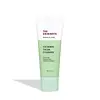What's inside
What's inside
 Key Ingredients
Key Ingredients

 Benefits
Benefits

 Concerns
Concerns

 Ingredients Side-by-side
Ingredients Side-by-side

Water
Skin ConditioningCocamidopropyl Betaine
CleansingPEG-90 Glyceryl Isostearate
CleansingSodium Laureth Sulfate
CleansingGlycerin
HumectantSodium Chloride
MaskingSodium Methyl Cocoyl Taurate
CleansingPhenoxyethanol
PreservativeLaureth-2
CleansingMethylparaben
PreservativeNiacinamide
SmoothingButylene Glycol
HumectantEthylhexylglycerin
Skin ConditioningPropylene Glycol
HumectantCentella Asiatica Extract
CleansingCaprylic/Capric Triglyceride
MaskingHydrogenated Lecithin
EmulsifyingHexylene Glycol
EmulsifyingStearic Acid
CleansingCholesterol
EmollientCeramide NP
Skin ConditioningWater, Cocamidopropyl Betaine, PEG-90 Glyceryl Isostearate, Sodium Laureth Sulfate, Glycerin, Sodium Chloride, Sodium Methyl Cocoyl Taurate, Phenoxyethanol, Laureth-2, Methylparaben, Niacinamide, Butylene Glycol, Ethylhexylglycerin, Propylene Glycol, Centella Asiatica Extract, Caprylic/Capric Triglyceride, Hydrogenated Lecithin, Hexylene Glycol, Stearic Acid, Cholesterol, Ceramide NP
Water
Skin ConditioningSodium Cocoyl Isethionate
CleansingGlycerin
HumectantHydroxypropyl Starch Phosphate
Sodium Methyl Cocoyl Taurate
CleansingDecyl Glucoside
CleansingPotassium Cocoyl Glycinate
Cetearyl Alcohol
EmollientGlyceryl Stearate
EmollientSorbitan Olivate
EmulsifyingGlycol Distearate
EmollientPotassium Cocoate
EmulsifyingCaprylyl Glycol
EmollientCitric Acid
BufferingPolyquaternium-67
Glyceryl Caprylate
EmollientDisodium EDTA
Sodium Acetate
BufferingSodium Chloride
MaskingPanthenol
Skin ConditioningPentylene Glycol
Skin ConditioningMadecassoside
AntioxidantWater, Sodium Cocoyl Isethionate, Glycerin, Hydroxypropyl Starch Phosphate, Sodium Methyl Cocoyl Taurate, Decyl Glucoside, Potassium Cocoyl Glycinate, Cetearyl Alcohol, Glyceryl Stearate, Sorbitan Olivate, Glycol Distearate, Potassium Cocoate, Caprylyl Glycol, Citric Acid, Polyquaternium-67, Glyceryl Caprylate, Disodium EDTA, Sodium Acetate, Sodium Chloride, Panthenol, Pentylene Glycol, Madecassoside
 Reviews
Reviews

Ingredients Explained
These ingredients are found in both products.
Ingredients higher up in an ingredient list are typically present in a larger amount.
Glycerin is already naturally found in your skin. It helps moisturize and protect your skin.
A study from 2016 found glycerin to be more effective as a humectant than AHAs and hyaluronic acid.
As a humectant, it helps the skin stay hydrated by pulling moisture to your skin. The low molecular weight of glycerin allows it to pull moisture into the deeper layers of your skin.
Hydrated skin improves your skin barrier; Your skin barrier helps protect against irritants and bacteria.
Glycerin has also been found to have antimicrobial and antiviral properties. Due to these properties, glycerin is often used in wound and burn treatments.
In cosmetics, glycerin is usually derived from plants such as soybean or palm. However, it can also be sourced from animals, such as tallow or animal fat.
This ingredient is organic, colorless, odorless, and non-toxic.
Glycerin is the name for this ingredient in American English. British English uses Glycerol/Glycerine.
Learn more about GlycerinChances are, you eat sodium chloride every day. Sodium Chloride is also known as table salt.
This ingredient has many purposes in skincare: thickener, emulsifier, and exfoliator.
You'll most likely find this ingredient in cleansers where it is used to create a gel-like texture. As an emulsifier, it also prevents ingredients from separating.
There is much debate on whether this ingredient is comedogenic. The short answer - comedogenic ratings don't tell the whole story. Learn more about comegodenic ratings here.
The concensus about this ingredient causing acne seems to be divided. Research is needed to understand if this ingredient does cause acne.
Scrubs may use salt as the primary exfoliating ingredient.
Learn more about Sodium ChlorideThis gentle cleansing and foaming ingredient is known for leaving a smooth feeling in skin and hair. It is made using coconut oil.
According to the manufacturer, it is soluble in water and has resistance to hard water, acid, and alkali.
Due to its coconut base, it may not be Malassezia folliculitis safe.
Learn more about Sodium Methyl Cocoyl TaurateWater. It's the most common cosmetic ingredient of all. You'll usually see it at the top of ingredient lists, meaning that it makes up the largest part of the product.
So why is it so popular? Water most often acts as a solvent - this means that it helps dissolve other ingredients into the formulation.
You'll also recognize water as that liquid we all need to stay alive. If you see this, drink a glass of water. Stay hydrated!
Learn more about Water